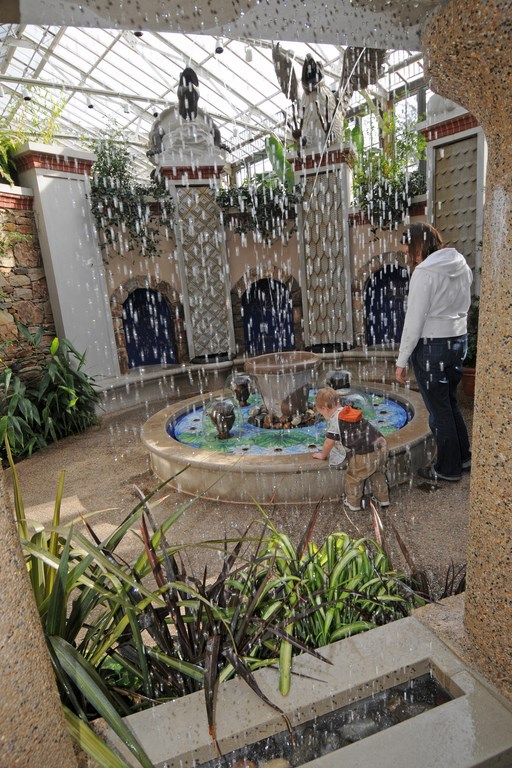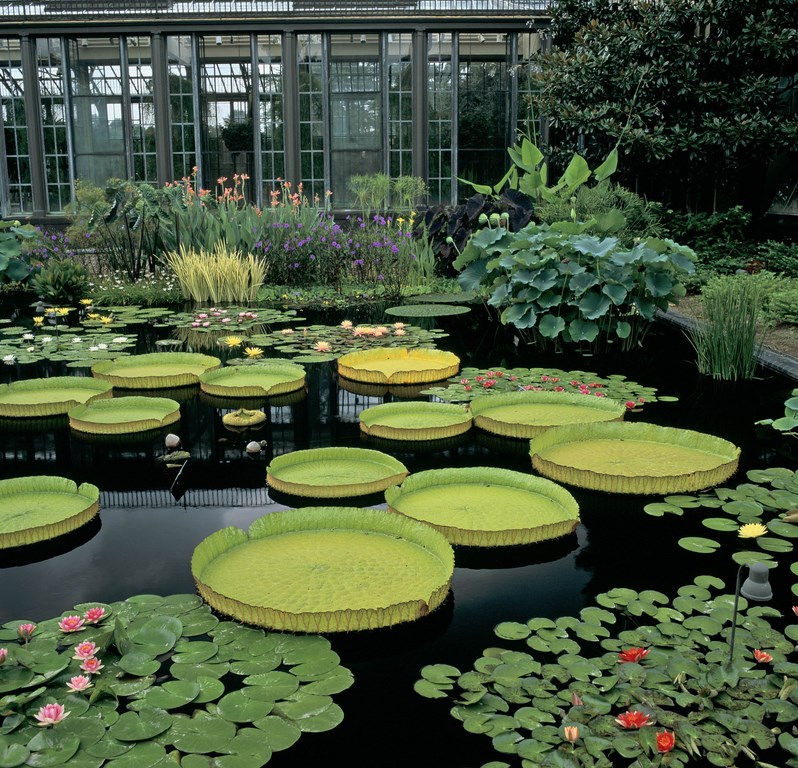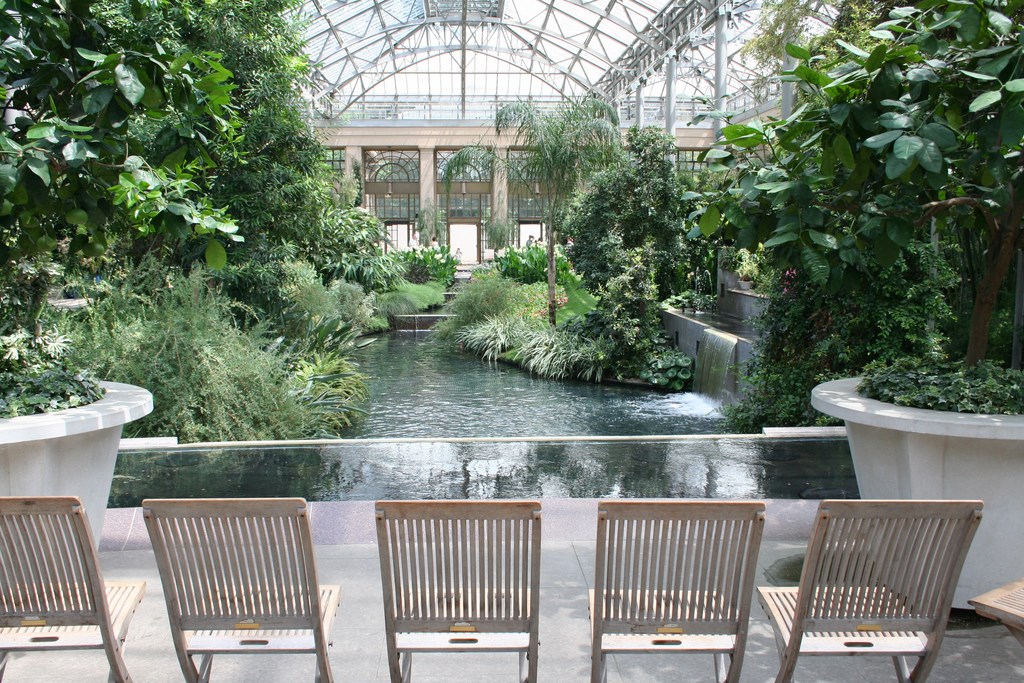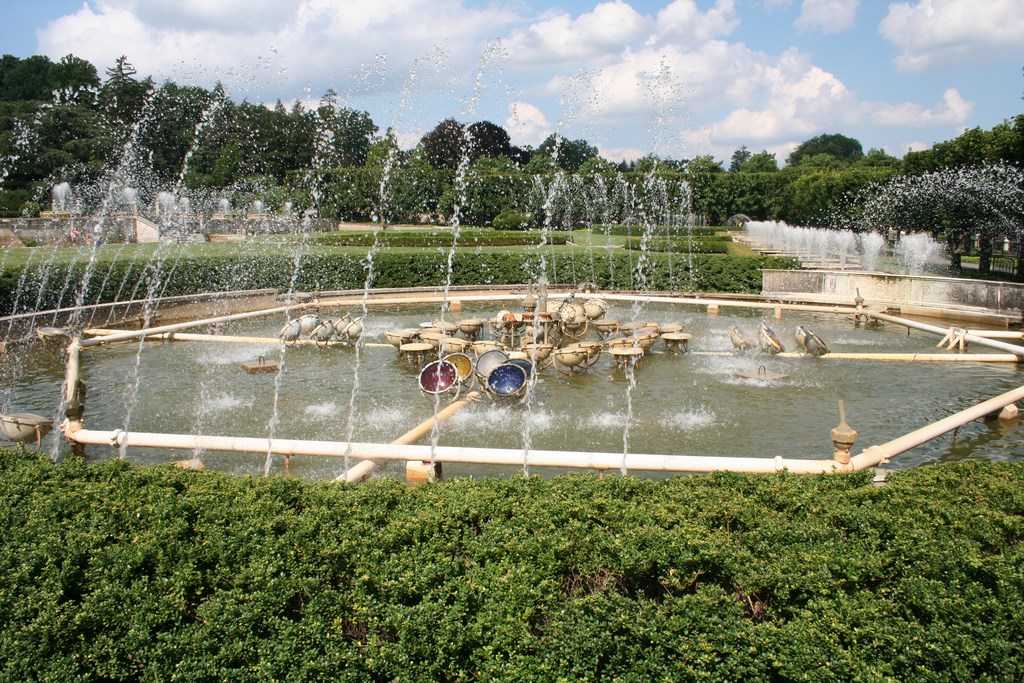Garden Grandeur
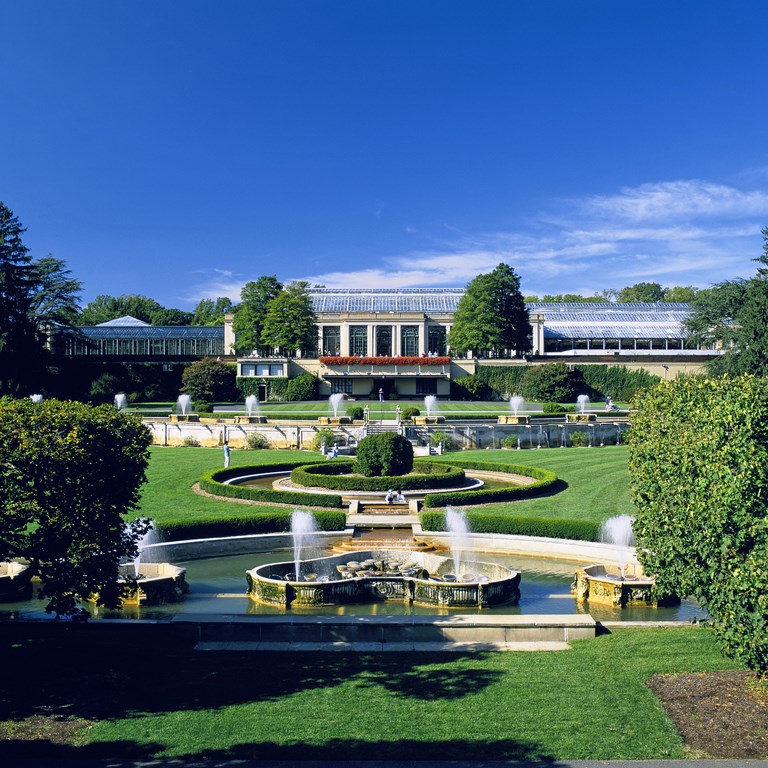
In pre-Colonial days, the neck of the woods now known as Longwood Gardens was a hunting ground for the Lenni Lenape tribe, who prized the area for the richness of its game and timber.
Once the British arrived, the land moved under the control of William Penn, founder (and namesake) of Pennsylvania, who sold it to a Quaker family by the name of Pierce in the year 1700. The family farmed the property until 1798, when Joshua and Samuel Pierce began planting an arboretum and the space that would one day become Longwood Gardens was born.
Those of us living in the Philadelphia area have long enjoyed the privilege of having this resource in nearby Kennett Square, Pa. It’s an amazing place, and I find my way there often because it seems that each time I go, there’s something
new to discover and fresh inspiration I can apply to my work as a watershaper and landscapedesigner.
Across its 1,050 acres, Longwood Gardens is spacious and open, but within its boundaries are a number of specific, well-defined garden spaces, attractions and utterly amazing fountains. Among many other things, for example, the property features a four-acre indoor conservatory, a 10,000-pipe organ, a total of 11,000 plant species – and dozens of wonderful watershapes seen at almost every turn.
Longwood Gardens may indeed be the finest display garden in the United States (if not the world), and the 825,000 annual visitors who make it the nation’s most-visited garden complex certainly seem to agree.
AN EYE TO HISTORY
Through the years, I’ve spent many pleasurable days tramping through Longwood Gardens, enjoying time with my children and exploring its diverse spaces. As a designer interested in expanding my own creative palette, I see the property as a living gallery – a workshop of ideas and an example of just how spectacular exterior design can be.
| Photos courtesy Longwood Gardens, Kennett Square, Pa. |
As it stands today, Longwood Gardens is largely the personal creation of Pierre S. du Pont, the industrialist and financer who ran a family firm (DuPont Chemical Co.) that his great-grandfather started early in the 19th Century.
Pierre du Pont purchased the property in 1906 and took full advantage of the fact that the Pierces had already established the space as a horticultural treasure. By 1850, the estate was known to house one of the country’s finest collections of trees. At that time, it was also run as a public park – one of the first in the nation and a model that prepared the way for many future public gardens.
Once he took control, du Pont immediately began transforming the property into a realm of boundless creativity in landscape design. Drawing inspiration from the great pleasure gardens of Europe, he also applied an uncannily progressive, nearly modern approach in combining old-world craftsmanship with state-of-the-art engineering practices and construction technology.
His hand is seen everywhere throughout the estate. In fact, the gardens and the fountains were all designed by du Pont himself: In addition to being a world-class horticulturalist, he was also one of the finest and most technically capable watershapers of his era.
|
Special Thanks I am extraordinarily grateful to the staff at Longwood Gardens for their help in preparation of this article. They provided me with all the information and photographs I could have wished for, and I particularly appreciate the time Colvin Randall, Longwood Gardens’ historian and fountain choreographer, spent with me in a recent visit: He’s a true gentleman and an invaluable resource. R.N. |
His love affair with fountains had started when, at age 23, he traveled to the 1893 World Colombian Exposition in Chicago and was awestruck by its grand water displays. He fed the obsession further with a visit to Italy’s Villa d’Este in 1910 – after which he reportedly said, “It would be nice to have something like this at home.”
After another trip to Europe, du Pont returned to Longwood and began work on an outdoor theater fountain. Another trip, this one to Florence, inspired the Italian Water Garden. Both are fully operational to this day – and still use much of the original equipment and plumbing as well as the water-effect fixtures du Pont himself designed and installed during his lifetime.
All of this was accomplished by a man who had no relevant professional training: He taught himself what he needed to know about horticulture, landscape design and watershaping – and did so at the same time he also happened to be running one of the largest companies in the world and managing the family’s vast philanthropic programs.
Most of du Pont’s worksheets survive in the garden archives and have been studied by professional aquatic engineers who’ve determined that his design calculations were nearly flawless – an exactitude evidenced by the fact that systems he designed and installed work almost perfectly today, after 70 and more years of service.
These pages offer nothing more than a brief visual introduction to Longwood Gardens – enough, I hope, to build your appetite to come to Philadelphia and see them for yourself.
Italian Water Garden
Inspired by his European travels in general and by Florence’s Villa Gamberaia specifically, Pierre du Pont started construction of his own Italian Water Garden in 1925. At first, the fountains had only a few effects, but over time it came to boast more than 600 jets and nine separate displays shooting from six blue-tiled pools and 12 pedestal basins along their sides.
Du Pont’s hydraulic calculations filled a good 50 pages, and even by today’s standards he had a masterful understanding of the dynamics of watershaping. As designed, the system recirculates a maximum capacity of 4,500 gallons per minute and was able to shoot water 40 feet into the air.
Du Pont also employed visual foreshortening in this space, using this type of forced perspective to make the composition appear more perfectly proportional when viewed from the observation area. He did this by making the distant pools 14 feet longer than the nearby pools.
The result has an enduring beauty befitting the European masterworks that inspired it. The beautifully curving water staircase and the arched niches with their sculpted fountains and terracotta jars are particularly noteworthy, and the carved limestone details add a distinctly Italian flavor.
The Theater Fountain
The theater fountain first took shape in 1914, but it has been considerably upgraded in the years since to serve as an even more admirable backdrop for theatrical performances, garden parties, concerts and other events designed to amuse du Pont’s extended family, friends and business associates.
While he was alive, the theater was a showcase for du Pont’s love of the performing arts and serves that purpose to this day. There are several choreographed fountain displays daily (the last time I visited, I caught a ten-minute performance set to a rousing rendition of “Stars and Stripes Forever”), and the current season includes full performances of the classic Broadway play “Oklahoma!” several nights each week.
During these spectacles, the fountains and colored lights (many of them originally installed by du Pont himself) are all running as performers move through their scenes and musical performances. The stage is encompassed by hedges to create a seating area for about 1,000 guests, and there’s a full orchestra pit down front.
These fountains were revolutionary in their day. Indeed, the way they used compressed air to blast water to greater heights is the same technology that designers of the Bellagio’s fountain displays applied to that spectacular Las Vegas fountain complex.
Photo at right courtesy Longwood Gardens
The Indoor Children’s Garden
More than a decade in the making, Longwood Gardens’ new 4,000-square-foot Indoor Children’s Garden triples the size of its predecessor and is designed to provide a safe, engaging area in which children can discover the joys of being in a garden.
Intricate waterfeatures are at hand to attract and maintain children’s interest at almost every turn. A shooting jet rings a bell, for example, and is joined by spitting fish, a pond with rising steam, a cave with dripping walls and a gigantic, drooling dragon. In all, young visitors will encounter more than 17 waterfeatures, most of which are interactive.
This array includes the Central Cove, a tree-covered seating area with a pool and flower-shaped water jets, jewel-like mosaics and three animal sculptures that shoot streams of water into the pool. There’s also a Rain Pavilion with water curtains on two sides that embrace kids with their gently falling water. (Up above is a glass ceiling covered by a thin sheet of flowing water.) A separate feature known as the Ramp also has a rain curtain, but in this case the space is augmented by a “glow-worm” leaping jet.
The drooling dragon is part of the Secret Room, which has a balcony overlooking the Central Cove. Nearby is the Square Maze, which has an obelisk at its center and walls accented by story tiles and jets of water. This is distinct from the Bamboo Maze, which offers a jungle of tree-size bamboo for children to explore and includes five visitor-activated waterfeatures accented by ornate bird sculptures.
Last but not least, kids will encounter the Grotto Cave and Tunnel, an area rigged with a shallow, fog-covered pool activated by water dripping from sculpted snakes coiled overhead.
Photos courtesy Longwood Gardens
Tasteful Bites
The grounds at Longwood Gardens include a number of water-related displays described in brief here.
WATER LILIES: Tucked into a protected courtyard is a set of pools filled with aquatic plants from all over the world, including more than 100 types of day- and night-blooming water lilies, lotuses, giant water-platters and various other aquatic and bog plants. The water in the 30-inch-deep pools is mixed with an organic black dye to slow algae growth and accentuate the appearance of the plants. (Photo at right courtesy Longwood Gardens)
EAST CONSERVATORY: Originally built in 1927 and 1928, this facility was the subject of a three-year renovation project and reopened in 2005. It was once known as the Azalea House and featured an outstanding collection of azaleas and rhododendrons. The new design draws on Moorish, French and Modernist styles in a way that is uniquely “Longwood” and features a waterfall and stream that bring sound and motion to the space.
EYE OF WATER: This Modernist waterfeature sits above a 90,000-gallon reservoir that supplies the Main Fountain Garden. It fires up each day at 9 am with an initial surge of 8,000 gallons per minute before dropping back to a smooth flow of 5,000 gallons per minute for the rest of the day.
CHIMES TOWER & WATERFALL: Stone unearthed during construction of the Main Fountain Garden was a partial source for the Chimes Tower & Waterfall, which was built in 1929. The tower has a 62-bell carillon, and water for its 50-foot cascade comes from a reservoir hidden beneath the Eye of Water.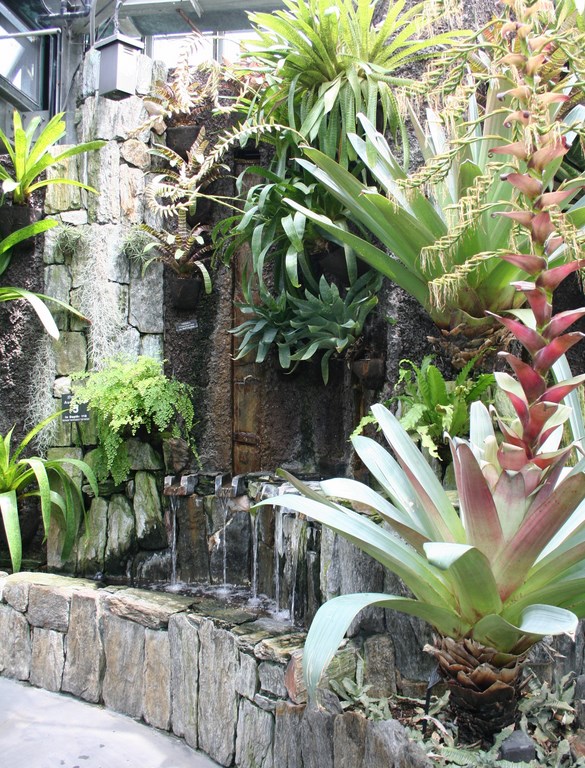
THE CASCADE GARDEN: Redesigned in 1992 by Brazilian landscape artist Roberto Burle Marx, the Cascade Garden takes full advantage of the vertical feeling of the adjacent greenhouse. Water splashes into clear pools here, while rich-textured plants cling to the walls and carpet the ground.
The Main Fountain Garden
It was in 1928 that du Pont began construction of his true masterpiece – a fountain display intended to rival the one he had seen in Chicago 35 years earlier. The 675,000-gallon-capacity pools and basins feature 380 fountain heads and spouts backed up by 18 pumps.
The original 1930 Worthington pumps and compressors are still in use today – a matched set of three 100-horsepower units that drive the daytime static displays at a rate of 4,000 gallons per minute. There are also 14 display pumps ranging from 20 to 75 horsepower: These are used to power the shows and move as much as 10,000 gallons per minute in combination with a pair of 40-horsepower air compressors that kick the water up to heights of 130 feet. (The last of the original compressor belts were replaced in 1999, having been in service for nearly 50 years.)
In total, there are 40 pneumatically controlled valves in the system, with 36 of them directly controlling the different show displays.
The Main Fountain Garden Fountain was first turned on in 1931, but it wasn’t until several years later that the five-acre space was actually completed with the addition of tons of carved limestone architectural and sculptural elements imported from Italy. Rising above the architecture and hardscape, du Pont created an instant forest where a cornfield had stood, bringing in several hundred mature trees and shrubs to provide a green backdrop for the limestone detailing.
Late each fall, the fountain system is completely winterized: All pumps and display valves are disassembled in a painstaking process that takes several months. And great care is required: No parts are available for the pumps, so when any breakage occurs, replacements must be custom made by the facility’s top-flight team of fountain technicians.
The first fountain displays were manually provided by a operator flipping as many as 200 toggle switches and 100 levers to actuate pumps and lights. The original control system is long gone, having been updated in 1965 and again in 1984 with computerized control systems that manage the fountains, the 674 colored lights and the occasional fireworks show with everything choreographed to flow along with classical music. More upgrades are coming: In years to come, these fountains will be the subject of a $60-million restoration project.
Photos courtesy Longwood Gardens
Robert Nonemaker is co-owner of Outerspaces, Inc., a business he started with his brother David at the age of 12. After a college career during which he studied construction management, communications, engineering and business, he decided to resume his work in the landscaping business. Shortly thereafter, he added watershaping to their array of services, and it now dominates the brothers’ business, which now employs 27 people and specializes in large, ultra-high-end, technically complex residential pool, fountain and landscape construction projects. He is also owner of Robert Nonemaker Exterior Design, a firm that offers design and construction consulting to architects and landscape architects throughout the country.















